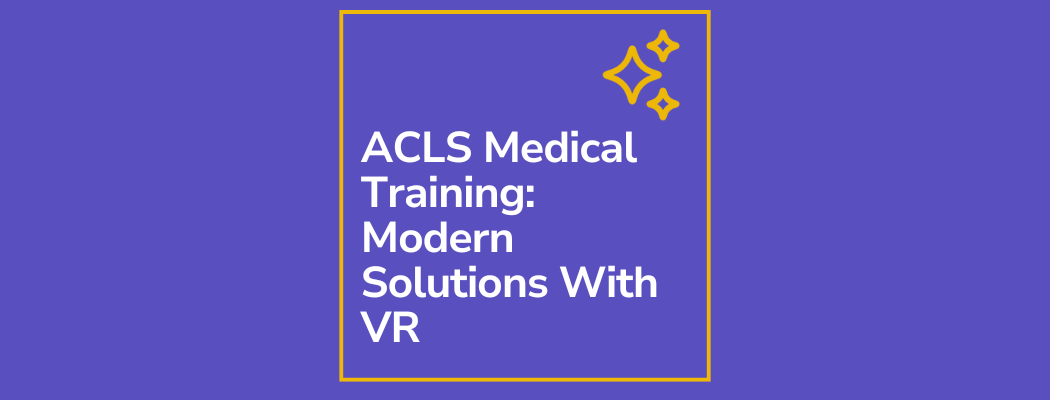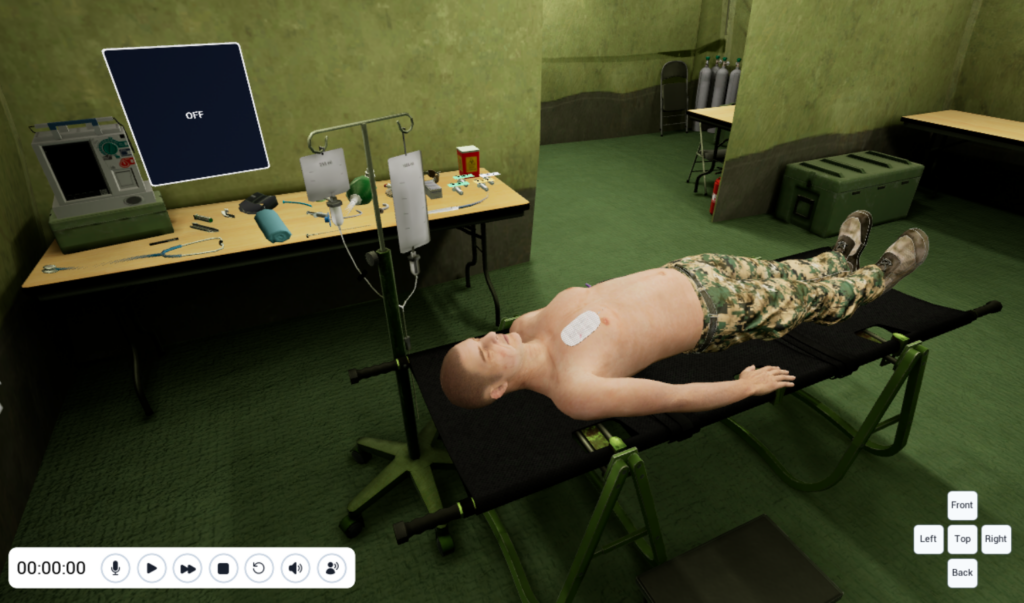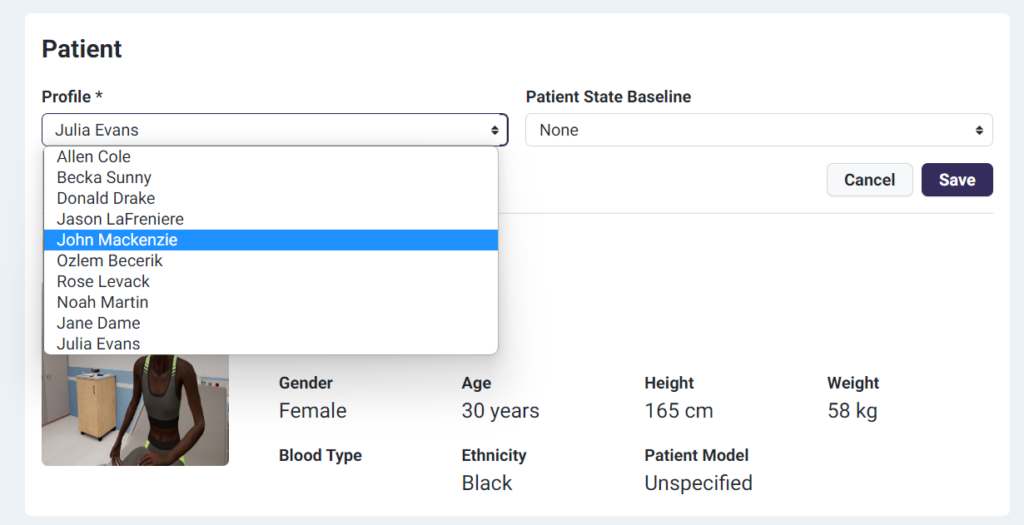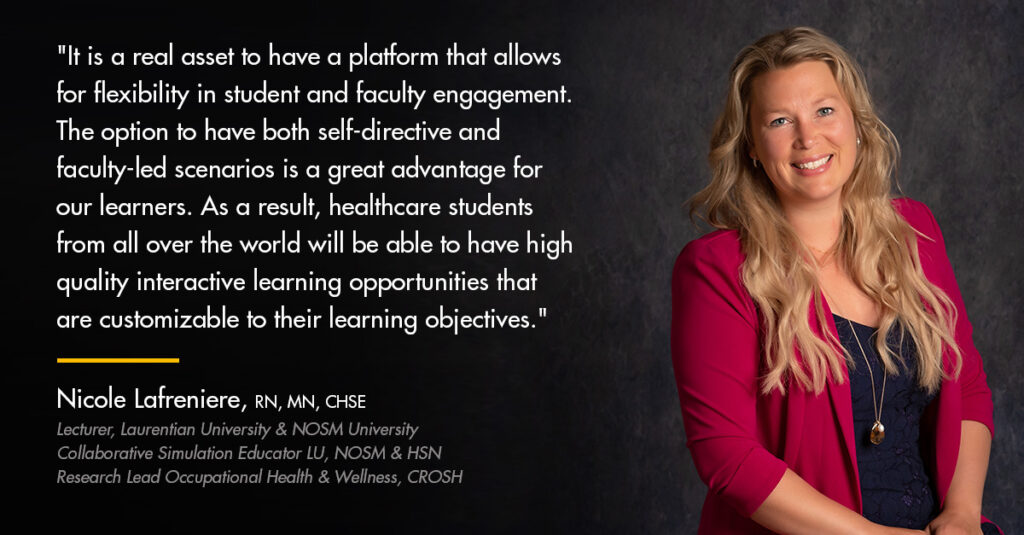
ACLS Medical Training: Modern Solutions With VR
ACLS Medical Training: Modern Solutions With VR
Interventions within the first six minutes of cardiac arrest have the highest chances of saving a life. That’s precisely where ACLS becomes indispensable.
ACLS training equips healthcare professionals with the skills to respond to life-threatening emergencies effectively.
In this guide, we will discuss ACLS’s significance in clinical practice and its core elements. We will also discuss how virtual reality helps with ACLS medical training.
What Is ACLS Medical Training?
Advanced Cardiovascular Life Support (ACLS) is a specialized set of clinical interventions and knowledge designed to address life-threatening cardiac emergencies. These emergencies include:
- Cardiac arrest
- Stroke
- Arrhythmias
- Acute coronary syndrome
- Severe bradycardia
According to the American Heart Association (AHA), ACLS encompasses advanced techniques in resuscitation, pharmacology, and the use of medical devices.
ACLS medical training is evidence-based and designed to help professionals make split-second decisions that save lives. It introduces systematic approaches like the “ABC” (Airway, Breathing, Circulation) assessment.
The American Heart Association introduced the first ACLS guidelines in 1974. Today, ACLS training is a global benchmark for emergency medical education. It’s a prerequisite for many roles in emergency medicine, critical care, and cardiology.
Today, ACLS training incorporates cutting-edge technologies like algorithms, virtual reality (VR), and artificial intelligence (AI). These tools offer immersive, hands-on experiences that enhance learning and retention.
Lumeto is an AI-powered healthcare training provider specializing in virtual reality (VR) solutions for medical education. Here’s a scenario from Lumeto’s training library demonstrating VR’s power in ACLS education.
CPR vs ACLS
CPR (Cardiopulmonary Resuscitation) and ACLS (Advanced Cardiovascular Life Support) play different roles in cardiac emergencies.
CPR focuses on chest compressions and rescue breaths. It is the first response to maintain circulation and oxygen. ACLS is designed for healthcare professionals. It goes beyond CPR and includes advanced airway management, medications, defibrillation, and ECG interpretation.
Importance of ACLS Medical Training
Each year, over 350,000 out-of-hospital cardiac arrests occur in the United States. Approximately 90% of these cases are fatal. The critical factor in improving survival rates is trained healthcare professionals’ immediate and effective response.
ACLS medical training equips providers with the advanced skills needed to assess, manage, and treat these emergencies
Improved Patient Outcomes
A 2018 study analyzing in-hospital cardiac arrest cases found that compliance with ACLS protocols significantly increased the rates of return of spontaneous circulation (ROSC) and survival to discharge.
Conversely, deviations from established ACLS protocols were associated with poorer outcomes.
A systematic review also revealed that healthcare providers who completed ACLS courses were better prepared to manage cardiac arrest situations.
Enhanced Team Coordination
One key concept introduced in ACLS is the Resuscitation Triangle. This framework assigns specific roles to team members, ensuring clarity and efficiency during high-pressure situations.
The Resuscitation Triangle includes:
- Team Leader: Directs the resuscitation process, makes critical decisions, and makes sure protocol compliance.
- Compressor: Performs high-quality chest compressions, maintaining the rhythm and depth recommended by guidelines.
- Airway Manager: Secures and manages the airway, often using advanced techniques like intubation or supraglottic devices.
It also trains team members to communicate using closed-loop communication, where orders are repeated and confirmed to avoid errors.
The video below shows a collaborative ACLS training session using Lumeto’s virtual reality platform.
Preparedness for Complex Scenarios
Real-life medical emergencies are rarely straightforward. Healthcare professionals often face complex scenarios that require quick thinking, advanced skills, and sound judgment. ACLS training prepares providers for these situations by simulating real-world challenges and equipping them with the tools to respond effectively.
Who Needs ACLS Medical Training?
ACLS medical training is essential for professionals who work in environments where cardiac emergencies are a real possibility.
Here are the primary domains where ACLS training is critical:
Emergency Medicine
Professionals working in emergency departments frequently encounter cardiac arrest, arrhythmias, and other life-threatening conditions. ACLS is a mandatory skill for emergency physicians, nurses, and paramedics, as it equips them to respond effectively in high-stress, fast-paced situations.
Critical Care Units
ACLS is a cornerstone for healthcare providers in intensive care units (ICUs) and critical care settings. These professionals manage critically ill patients who may experience sudden cardiac events, requiring immediate and advanced interventions.
Prehospital Providers
Paramedics and first responders are often the first to attend to out-of-hospital cardiac arrests. ACLS training enables them to initiate advanced life support measures, bridging the gap until the patient reaches the hospital.
Nursing Staff
Registered nurses in hospitals, clinics, and long-term care facilities often require ACLS certification. This training makes sure they can assist during emergencies and perform advanced interventions when needed.
Firefighters
Firefighters often face emergencies involving smoke inhalation or cardiac distress from high-stress rescue operations. ACLS training enhances their ability to manage these situations until advanced medical teams take over.
Military Nursing and Medical Personnel
Military nurses and medics operate in challenging environments where access to advanced medical facilities may be delayed or limited. ACLS training is critical for managing cardiac emergencies in combat zones, field hospitals, or during medical evacuations. It enables military healthcare personnel to provide life-saving care under extreme conditions.
Here’s an example of a military-focused ACLS training scenario provided by Lumeto:

What Is Included in ACLS Training?
ACLS medical training focuses on preparing healthcare professionals for critical cardiac emergencies. The training includes techniques, decision-making strategies, and teamwork practices.
Basic Life Support Skills
Basic life support (BLS) forms the foundation of ACLS training. BLS skills are included in ACLS training to make sure seamless integration with advanced techniques.
The key BLS skills covered include:
- High-quality chest compressions
- Rescue breaths using bag-valve masks
- Use of an automated external defibrillator (AED)
- Rapid assessment of airway, breathing, and circulation
- Activation of emergency response systems
- Proper hand placement and compression depth during CPR
Recognition and Management of Cardiovascular Emergencies
Participants are trained to recognize and respond to various cardiovascular emergencies, such as cardiac arrest, stroke, arrhythmias, and acute coronary syndromes.
Here’s a video example of how virtual reality training brings these scenarios to life:
Pharmacology
Pharmacology training includes when and how to administer drugs like epinephrine, amiodarone, and atropine, as well as their mechanisms of action, dosages, and potential side effects.
Airway Management
A functional airway is essential for oxygen delivery to the body during cardiac emergencies. Without proper oxygenation, vital organs like the brain and heart can sustain irreversible damage within minutes.
In cardiac arrest and other critical scenarios, patients often lose their ability to breathe effectively. ACLS equips participants with advanced airway management skills, including:
- Bag-valve masks,
- Endotracheal intubation,
- Supraglottic airway devices.
Electrocardiogram (ECG) Interpretation
Training includes interpreting ECG rhythms to identify arrhythmias, such as ventricular fibrillation, tachycardia, or bradycardia.
Trainees practice identifying rhythms in real-time scenarios using simulated ECG monitors or VR tools.

The image above shows a simulated patient monitor used in training. It displays key parameters such as heart rate (HR), oxygen saturation (SpO2), and plethysmography (Pleth) waves. This setup challenges trainees to interpret rhythms, detect abnormalities, and make critical decisions. For instance, a heart rate of 130 may indicate tachycardia, prompting appropriate interventions based on ACLS protocols.
Effective Communication
Effective communication is vital during cardiac emergencies, where every second counts. In ACLS medical training, team members learn to communicate critical information quickly and accurately.
Lumeto introduces an innovative preparation layer with AI-powered virtual patients to enhance communication skills. Virtual patients simulate real-world scenarios and respond to verbal commands, creating an interactive environment.
Here’s a video example where a trainer asks an AI patient (facing stroke symptoms) to lift their right and left leg, demonstrating how realistic and responsive these virtual patients can be.
Challenges in ACLS Medical Training
Trainers have faced several challenges in providing effective ACLS medical training. But, advancements in virtual reality, artificial intelligence, and other technologies are helping bridge this gap.
Here’s how these innovations address some of the biggest obstacles in ACLS training.
Limited Access to Hands-On Training
In traditional settings, trainees often rely on mannequins, pre-programmed simulations, or scripted scenarios to practice ACLS protocols. While these methods provide a foundational understanding, they lack the complexity and unpredictability of real-world emergencies. These tools often fail to simulate the nuanced reactions of a live patient.
Lumeto solves this challenge by offering a highly customizable healthcare training platform. Here’s an image showing Lumeto’s customization interface.

With over 800 customization tools, Here’s what trainers can control in Lumeto:
- Patient Information and Medical History: Create patients with unique medical backgrounds to simulate specific cardiac conditions or comorbidities.
- Patient Symptoms & Baselines: Adjust symptoms such as heart rate, oxygen saturation, or blood pressure to mimic realistic clinical presentations.
- Patient Dialogue & Responses: Incorporate verbal and non-verbal responses, including language support, to improve communication training and make scenarios more engaging.
Time Constraints for Busy Professionals
Not every healthcare provider has the time to attend onsite training sessions due to demanding schedules, rotating shifts, or geographic barriers. Additionally, traditional training sessions are typically scheduled at fixed times, which may not align with the availability of all participants.
Lumeto addresses these challenges with flexible training options:
- Remote and Onsite Training: Offers the flexibility to participate in training from anywhere or attend in-person sessions when feasible.
- Observer Mode: Enables classroom learners to watch training scenarios unfold, helping them gain valuable insights and knowledge without active participation.
Lumeto offers both asynchronous and synchronous training options. Asynchronous training allows participants to learn at their own pace and complete modules when their schedules permit. For those who prefer live interaction and real-time feedback, synchronous training provides a dynamic alternative.

Cost of Advanced Training Programs
One of the significant challenges in ACLS medical training is the high cost associated with advanced programs. Traditional training requires access to skilled trainers and fully equipped facility centers.
Some institutions or organizations offer ACLS medical training scholarships to make the program more accessible for students and professionals.
Lumeto addresses this challenge by providing a cost-effective, tech-driven solution. The virtual reality platform reduces the need for physical training centers and expensive equipment.
Our adaptable training modules allow healthcare organizations to standardize training across systems of care without significant reinvestment. Trainers can design and run customized scenarios without requiring physical mannequins or specialized facilities.
How Lumeto VR Helps in ACLS Medical Training
Lumeto VR provides an advanced platform for ACLS medical training through innovative tools and technologies. It is designed to address specific training challenges while providing healthcare professionals with the skills and confidence they need for real-world emergencies.
Here’s how it works:
100+ Immersive Learning Experiences
Lumeto offers over 100 immersive training scenarios that simulate real-life cardiac emergencies. These scenarios include high-pressure situations such as chest pain, cardiac arrest, and advanced airway procedures.
Powerful Performance Management Tools
The platform incorporates AI-powered tools for skills testing and assessing trainee performance. Trainers can monitor metrics like compression depth, ventilation rates, and protocol adherence.
AI-Powered Customization for Patient Scenarios
Trainers can adjust multiple variables to enhance learning outcomes, such as:
- Scenario environment
- Medications, including dosages
- Patients’ labs & tests
- Assessment criteria & weighages
- Competency mapping and tracking
Experience the future of ACLS training with Lumeto’s immersive VR platform. Book a demo today!
Frequently Asked Questions About ACLS Medical Training
How Long Does ACLS Certification Take?
The duration of ACLS certification courses varies but typically ranges from 8 to 16 hours over one to two days. Recertification courses are shorter and usually completed within a single day.
How Long Is ACLS Certification Valid?
ACLS certification is valid for two years. After this period, healthcare professionals must complete a recertification course to maintain their credentials. Most certifications include a unique identifier, such as a certification number for ACLS medical training verification.
Is ACLS Training Difficult?
ACLS training can be challenging due to the complexity of protocols and the high-pressure scenarios it covers. But hands-on practice, and access to modern training tools like VR can make it more manageable.
Do I Need Prior Experience to Take ACLS Training?
Participants are expected to have prior knowledge of BLS and basic cardiac concepts. Pre-course materials are often provided to help prepare for the training.
Can ACLS Be Taken Online?
Yes, many organizations now offer hybrid or full ACLS medical training online. These often include self-paced modules for theory and in-person or virtual hands-on practice sessions.
What Is the Difference Between ACLS and PALS?
ACLS focuses on managing cardiac emergencies in adults, while PALS addresses cardiac and respiratory emergencies in infants and children with age-specific protocols.